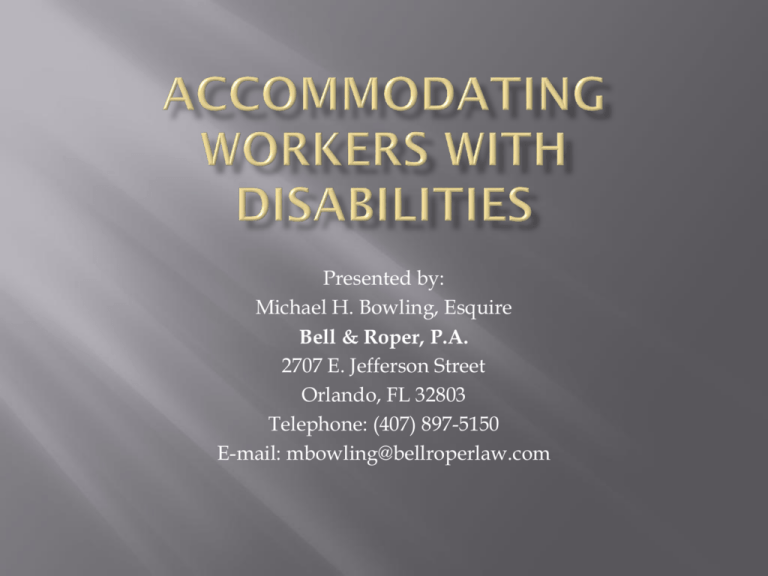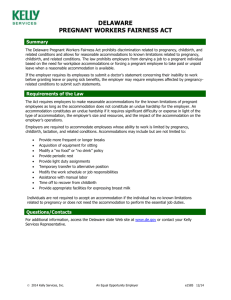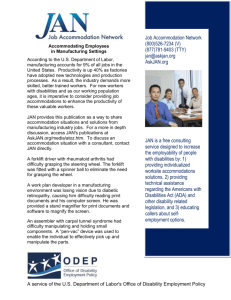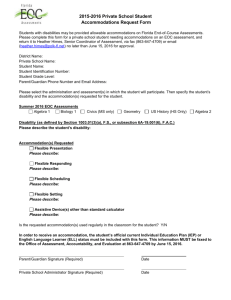2015-16 Accommodating Workers With
advertisement

Presented by: Michael H. Bowling, Esquire Bell & Roper, P.A. 2707 E. Jefferson Street Orlando, FL 32803 Telephone: (407) 897-5150 E-mail: mbowling@bellroperlaw.com Expansion under ADAAA Large majority of ADAAA cases are getting past disability to other aspects of the case Accommodations not available for "regarded as" Employee asks explicitly Employee asks but does not use the magic words Employee demonstrates need Guaranteed leave exhausted and medical provider states additional accommodations are necessary Tips for Employees: Be clear about ability to perform essential functions as well as your limitations Be flexible Follow up Be aware of what you need to reveal about underlying medical condition Overview of RA accommodation obligation Advise employees how to request RA (HR not supervisors) Examples of RA Encourage but don't require written request Alert employees medical documentation may be required Alert employees they may receive an effective alternative accommodation Alert employees to a RA in the LOA policy Spouse calls supervisor rather than Human Resources per policy and says husband is having anxiety attacks and can't keep up with new increased production requirements. What should the supervisor do? What should Human Resources do? A job function may be essential because: The reason the job exists is to perform that function There are a limited number of employees available among whom the performance of that function can be distributed and/or The function is highly specialized Employers are the best judges of whether a function is essential, but the best time to do it is before a disability claim. Take control by updating job descriptions and other materials defining essential functions Essential vs. marginal job function analysis Amount of time spent performing the function Consequences of not performing the function How past incumbents worked in same job Experience of current incumbents in same or similar jobs EJFs for the same position may vary depending on the location or business unit where the individual works Functions that are not essential are considered "marginal" functions of the position Three categories of reasonable accommodation: Modifications/adjustments to a job application process Modifications/adjustments to the work environment or adjustments in how and when a job is performed. Modifications/adjustments that enable an employee to enjoy equal benefits and privileges of employment Examples of reasonable accommodations: Job restructuring Essential functions do not have to be eliminated Part-time or modified work schedules Leaves of absence Working from home Acquiring or modifying equipment Changing tests, training materials or policies Reassignment to a vacant position for which the employee is otherwise qualified An employer may require medical documentation verifying the disability, restrictions and need for accommodation Job related and consistent with business necessity Limited to specific condition at issue Employee has duty to cooperate Certain circumstances where employer cannot ask for documentation Employee's healthcare provider v. Employer's healthcare provider v. Independent health care provider Employee's failure to cooperate How many chances do you have to give an employee Documenting the employee's lack of cooperation The medical documentation states the employee has an anxiety disorder that impacts his ability to concentrate. Employee says if production standard were lowered to 50 rather than 60 files per hour, he thinks he could succeed. All employees are held to a production standard of 60 per hour. Human Resources knows ADA doesn't require an employer to lower production standards and closes employee's RA request. Individualized assessment Act promptly; unnecessary delays can result in a violation of the ADA Do not use as an excuse to demote, fire or any other adverse action Dialogue, dialogue, dialogue Never say never at the beginning of this conversation Think out of the box Consider an effective alternative accommodation Document, document, document Follow-up during and after Follow-up to determine if accommodation works and is still needed Undue hardship Significant difficulty or expense Financial difficulty almost always a loser Better to focus on whether the reasonable accommodation is unduly disruptive or fundamentally alters the nature or operation of the business Negative impact on morale and employee's/customer's fears doesn't support undue hardship Case-by-case determination Document, document, document Following a routine process doesn't mean it's not individualized does it? Pitfalls Consider interactive process notes and RA log Look to employer's leave policy If leave under policy is inadequate, then look to FMLA if applicable and ADA Generally, leave should be treated as reasonable accommodation when: More is needed than employer would usually provide and/or Leave is needed for a purpose for which employer generally does not provide it No fault attendance policies -- employee can have a certain number of unplanned absences during a year, after which the employee is disciplined No fault leave policies -- apply to extended leave and limit amount, after which employee can be terminated Both may have to be modified as a reasonable accommodation Employee who has migraine headaches that result in intermittent absences from the office is disciplined under an attendance policy when she exceeds the limit of five unplanned absences in a 12-month period. Did employee ever request reasonable accommodation? If accommodation was not requested, may employer proceed with discipline? If accommodation was requested, either before or after discipline, what should employer do? Assuming timely request is made, are employee's migraine headaches a disability within the meaning of the ADA? What are possible accommodations? Nature of the job Ability of other employees to take on work Consequences to the employer if work does not get done Frequency, duration, unpredictability of leave Employer and employee both must engage in good faith in the interactive process during a period of leave Employer can get documentation if disability and need for accommodation (including additional leave) aren't obvious Good idea for an employer to provide notice before period of extended leave expires Employer can ask for periodic updates if leave has not been granted for a specific period of time Can employee give any indication of whether or when she will be able to return? Length of the leave The nature of the job What happens to the employee's work during the period of leave (e.g., are there burdens on other employees?) Ability to fill the position on a temporary basis if work can't be done otherwise Accommodation of last resort There must be a vacant position (one that is available or will become available within a reasonable amount of time) The employee must be qualified for the new position, though not necessarily best qualified Must be equivalent position or as close as possible to original position Does not have to be a promotion, though employee may compete for a promotion Generally, employer need not reassign an employee as an accommodation where a more senior employee is entitled to the position, though "special circumstances" may require reassignment in some instances 2707 E. Jefferson Street Orlando, FL 32803 Telephone: (407) 897-5150 Facsimile: (407) 897-3332 www.bellroperlaw.com







